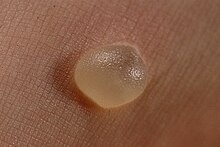
Back تبثر Arabic Пинкь AV Pullullu Aymara Blodan BAR ফোস্কা Bengali/Bangla Butllofa Catalan Puchýř Czech Vabel Danish Hautblase German Πομφός Greek
| Blister | |
|---|---|
 | |
| Blisters from abrasive rubbing are common on the feet. | |
| Specialty | Dermatology |
| Causes | Heat, cold, electricity, chemicals, friction, radiation |
A blister is a small pocket of body fluid (lymph, serum, plasma, blood, or pus) within the upper layers of the skin, usually caused by forceful rubbing (friction), burning, freezing, chemical exposure or infection. Most blisters are filled with a clear fluid, either serum or plasma.[1] However, blisters can be filled with blood (known as "blood blisters") or with pus (for instance, if they become infected).
Smaller blisters are called blebs. The word "blister" entered English in the 14th century. It came from the Middle Dutch bluyster and was a modification of the Old French blostre, which meant a leprous nodule—a rise in the skin due to leprosy.
In dermatology, the words vesicle and bulla refer to blisters of smaller or greater size, respectively.[2]
Some sources recommend not to pop a blister. If popped, bacteria can enter. Excess skin should not necessarily be removed as the top layer protects the soft tissue underneath.[3]
- ^ Uchinuma, E; Koganei, Y; Shioya, N; Yoshizato, K (1988). "Biological evaluation of burn blister fluid". Annals of Plastic Surgery. 20 (3): 225–30. doi:10.1097/00000637-198803000-00005. PMID 3358612.
- ^ Jonkman, Marcel F.; Horváth, Barbara (2022). "2. Dermatological examination of bullous diseases". In Horváth, Barbara (ed.). Autoimmune Bullous Diseases (2nd ed.). Switzerland: Springer. pp. 11–28. ISBN 978-3-030-91557-5.
- ^ "Should you pop a blister? When to do it, safe methods, and tips". www.medicalnewstoday.com. 2019-07-29. Retrieved 2022-10-14.